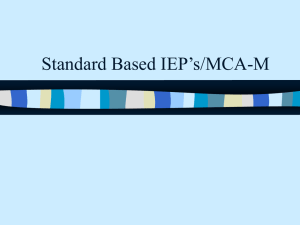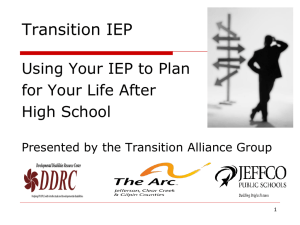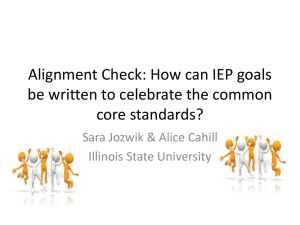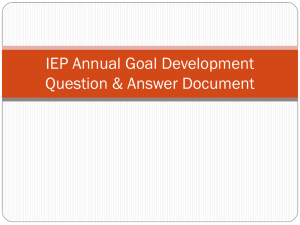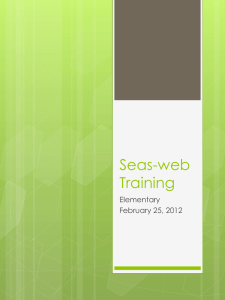Common Core Aim - Idaho Training Clearinghouse
advertisement
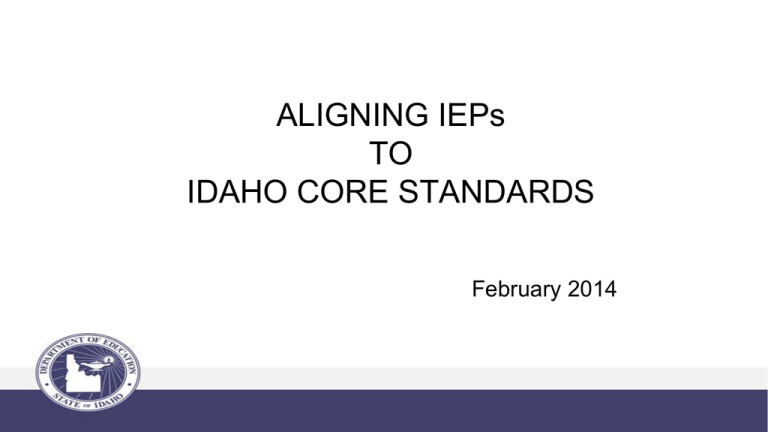
ALIGNING IEPs TO IDAHO CORE STANDARDS February 2014 Training Objectives • Participants will develop an understanding of the Idaho Core Standards. • Participants will develop an understanding of how to how to support positive outcomes for students. • Participants will develop an understanding of standardsbased IEPs. • Participants will develop an understanding of the process of aligning IEPs with Idaho Core Standards. Common Core Aim • Student learning expectations are consistent and clear so teachers and parents know what they need to do to help them. • Designed to be robust and relevant to the real world, reflecting the knowledge and skills youth need for success in college and careers. • By fully preparing American students for the future, our communities will be best positioned to compete successfully in the global economy. Common Core State Standards Commission IDAHO CORE STANDARDS Where is Idaho in the Process? • 2011 Adoption of Idaho Core Standards • 2011-2013 Professional Development provided to districts • 2013-2014 First year the ICS are fully implemented in Idaho schools • Spring 2014 New state assessment which fully aligns with the Idaho Core Standards Where is Idaho in the Process? • 2013-2014 Districts will align IEP goals and objectives to the Idaho Core Standards • 2013-2014 ISAT-ALT will continue to be based on the Extended Content Standards Idaho Assessments • SBAC = New ISAT o Field Testing Spring 2014 All students in grades 3-8 and 11 Students in grades 9 and 10 are optional o Participation in the SBAC Field Test will not affect any school’s Star Rating this year • Old ISAT o Students in grades 11 & 12 when applicable to meet IEP requirements If you have questions about the Smarter Balanced Field Test, please contact: TJ Bliss at tjbliss@sde.idaho.gov or Angela Hemingway at ahemingway@sde.idaho.gov Idaho Assessments • Alternative Assessment o Pilot Alternative Assessment 2013-2014 o New Alternative Assessment will be implemented by 2014-2015 If you have questions about the Alternative Assessments please contact Toni Wheeler at tcwheeler@sde.idaho.gov Idaho Core ELA Key Shifts • Shift One: Students will build knowledge and academic language through a balance of content rich, complex nonfiction and literary texts. • Shift Two: Reading/Writing/Speaking is grounded in evidence from the text, across the curriculum. • Shift Three: Students will use digital resources strategically to conduct research and create and present material in oral and written form. • Shift Four: Students will collaborate effectively for a variety of purposes while also building independent literacy skills. Key Aspects of ELA Standards • Four strands under the College and Career Readiness Anchor Standards Reading Writing Speaking and Listening Language • Articulation of literacy standards across the content areas CCR Anchor Standards Math Content Standards Organized in a hierarchy: Domain • Big ideas that connect standards and topics (sometimes across grades) Cluster • A group of related standards • Each standard captures several ideas which summarizes the important aspects of their domain Standard • Describes what students should understand & be able to do Example of a Math Clusters and Domains Domain Clusters Example of a Math Domain, Clusters and Standards Activity: Idaho Core Standards • Find a standard in either the Math or the ELA Standards for your assigned grade level that stands out to you. • Share out why you chose that particular standard. Idaho Core Standards (ICS) Learning Progressions Framework (LPF) Core Content Connectors (CCC) Learning Progressions Framework (LPF) • Were developed to be used with the CCSS • Does NOT provide details of grade-specific curriculum • Describes student learning as an ongoing developmental progression • A starting point for thinking about how students develop competency in an academic domain Example from ELA LPF Example from Math LPF Core Content Connectors (CCC) • Prioritizes academic content by grade level for both the Math and ELA standards • Help to focus on the core content, knowledge, and skills needed at each grade level • Help IEP teams identify priorities in Math and ELA areas when developing goals and objectives • Help guide instruction for students participating in the alternative assessment Core Content Connectors: ELA http://www.sde.idaho.gov/site/assessment/ISATalt/Instruction.htm Core Content Connector: Math Educational Alignment IDAHO CORE STANDARDS INSTRUCTION ASSESSMENT General Education Content Standards • Idaho Core Standards (All grades) • Idaho Health & PE Content Standards (All grades) • Idaho Extended Alternative Standards (2013-2014 is the last year to use these standards) • Basic Workplace Competencies (All grades) • eGuidelines for Preschool (Social/Emotional Development & Approaches to Learning and Cognitive Development used through 3rd grade) Activity: Processing Worksheet Complete “Current Process” column only SUPPORTING POSITIVE OUTCOMES FOR STUDENTS Positive Outcomes for Students • Although the ICS sets high student expectations, the standards allow flexibility for multiple means of access • If we create appropriate and flexible learning environments for all students, we can accommodate individual learning differences and maximize their learning Educational Structure High Quality Standards ResearchBased Curriculum & Instruction EvidenceBased Practices Leads to appropriate and flexible student learning Aids and Supports Relevant Assessments Educator Collaboration Positive Student Outcomes • Create a comprehensive educational structure which will lead to appropriate and flexible student learning • Establish a framework for flexible learning environments within general education classrooms which will provide all students access to the general education curriculum such as the Universal Design for Learning (UDL) The Universal Design for Learning (UDL) • The UDL is an educational framework which guides the development of flexible learning environments which can accommodate individual learning differences. • The use of UDL within general education classrooms can provide all students access to the general education curriculum. Three Principles of UDL 1. Multiple Means of Representation: Presentation of information in various formats and with multiple media 2. Multiple Means of Action and Expression: Allows students to respond and demonstrate what they know through a variety of formats 3. Multiple Means of Engagement: Provides ways to engage learner attention and motivate student learning UDL: Multiple Means of Representation • • • • • Visual Displays Graphic Organizers Videos PowerPoint Presentations Picture Symbols Paired with Text UDL: Multiple Means of Action & Expression • • • • • • Gallery Walks Line-Ups Communication Systems Text-to-Speech Translators Strategy Tools Checklists UDL: Multiple Means of Engagement • Teach self-regulation explicitly • Provide choices for students • Allow students to participate in the design of classroom activities and academic tasks • Role Play Connecting UDL and ICS Connecting ICS and UDL • ICS provides the goal standards which will be most effective for students • UDL provides the means to increase student achievement of the ICS Supporting Student Achievement Supporting the educational achievement of our students in special education programs requires schools to have an understanding of: • Ownership – students receiving special education services are the responsibility of all • High Expectations – understanding all students will be challenged and expected to perform to the best of their ability Educators Working Together Special Educators Improving Student Achievement General Educators Administrators Activity: What Can You Contribute? • As a table, discuss your roles as special educators. What can you contribute to your building team as you implement the Idaho Core Standards? • Each table will share out one contribution. Collaboration of Special & General Educators Special Educators can share knowledge and experience about: • Evidence-based teaching practices • Implementation of the Universal Design for Learning • Accommodations and supports to help students access the general curriculum General educators can share knowledge and experience about: • Curriculum resources • Content resources COLLABORATION IEP DEVELOPMENT Importance of Aligning IEPs to Standards Federal law requires that students with disabilities: • Have access to the general curriculum • Be involved in the general curriculum • Progress in the general curriculum Alignment Student's Present Levels How can we align student’s skills, knowledge and behaviors? Idaho Core Standards IEP Components • How the student’s disability affects involvement and progress in the general curriculum (PLAAFP/PLOP) • How the student will be involved in and progress in the general curriculum (Goal) • Supplementary aids and services to help the student be involved in and progress in the general curriculum (Accommodations-Adaptations/Modifications) • Why the student will not participate with children without disabilities in general education (LRE) Supplementary Aids and Services In order to enable the student to access, be involved in and progress in the general curriculum, the IEP must contain a description of: • Accommodations and modifications to the curriculum • Accommodations and modifications to how curricular information is provided • Direct special education and related services and supports to the student and to people who work with the student Supplementary Aids and Services • The IEP should only include a list the supplementary aids and services determined necessary by the team for the student to access the general curriculum. • The listed supplementary aids and services need to be related to the areas of need that have been identified in the PLAAFP/PLOP and Goals. Assessment Participation • Students with disabilities are required to take part in state and district-wide assessments, when appropriate. • The IEP Team will determine the necessary accommodations or modifications necessary for the student to participate in the assessments. • If the IEP Team decides the assessment is not appropriate for the student, they will state why that assessment is not appropriate and how the student will be assessed. IEP Development Review the student’s grade-level ICS in area of concern Identify the skills needed to meet grade-level standards Assess student’s skills related to standards Determine how disability prevents student from mastering standards Develop goal to address identified needs Identify services and supplementary aids and supports needed to access curriculum Identify appropriate educational placement IEP: Present Levels of Academic Achievement and Functional Performance The Present Level of Academic Achievement and Functional Performance (PLAAFP) is the same as The Present Level of Performance (PLOP) (PLAAFP is the wording used by the IDEA) Legal Requirements • Each IEP must include a statement of the child’s present levels of academic achievement and functional performance (PLAAFP), including how the child’s disability affects the child’s involvement and progress in the general education curriculum. • For preschool children, as appropriate, how the disability affects the child’s participation in appropriate activities. • For students with transition IEP’s (ages 15 and older) the PLAAFP must be related to future employment, education/training, and daily living skills. IDEA (Sec. 300.320(a)(1)) Legal Requirements IEPs need to include statements of present levels of academic achievement and functional performance. Each statement shall: • Be written in objective, measurable terms and easy-tounderstand non-technical language • Show a direct relationship with the other components of the IEP • Provide a starting point for goal development • Reference general education standards Idaho Special Education Manual February 2007 revised 2009 Academic Achievement and Functional Performance Academic Achievement: Describes student’s performance in the academic areas Functional Performance: Describes how the student applies his or her skills in the context of the routine activities of everyday living Develop a Meaningful PLAAFP/PLOP IEP Team should consider the: • Grade level expectations (ICS) • Student’s performance on the skills related to mastering the gradelevel standards (data-based assessment information) • Student’s disability impact on involvement in and progress in the general education curriculum • Strengths and needs of the student related to the area of concern • PLAAFP/PLOP as the starting point of the IEP and link it to the other components of the IEP Idaho IEP Goal Page PLAAFP/ PLOP Present Levels (PLAAFP/PLOP) Components PLAAFP/PLOP Components Student Information Summarize the current assessment data which includes student strengths, needs and data-based information describing the student’s current academic achievement and functional performance in the areas of need related to the disability (written in objective and measureable terms) Description of the impact/effect of the disability on the student’s progress and involvement in the general curriculum Reference the student’s grade-level content standards Ensure there is a direct link between the PLAAFP/PLOP and the Goal as well as other components of the IEP Refer to the Goal and other components of IEP to ensure a direct relationship: Goal: ☐ LRE: ☐ Supplementary, Aids, and Services (Accommodations, Adaptations/Modifications): ☐ Collecting Information for PLAAFP/PLOP Once the standard has been identified (related to the student's area of need), collect the following data: • Progress monitoring data on previous goals • Informal assessment data collected during the year • Information offered from general education teachers and other service providers related to the child’s day-to-day school routine • Parent input • Information collected from most recent eligibility evaluation Current Assessment Data • The description of current assessment data should be written in objective and measurable terms (baseline data). • The data can be gathered from a variety of data sources which are consistent with the most recent evaluation (including parent input). • Data may include, but is not limited to: criterion-referenced tests; curriculum-based measurements; norm-referenced tests; checklists; observations; functional behavioral assessments; state/district assessments; parent interviews; work samples; behavior rating scales; etc. • Include a summary of the student’s strengths and needs as well. Current Assessment Data Example: Colton identifies the names and sounds of all letters. He can read basic sight words and sound out words with one syllable. Colton averages 20% on his second grade classroom reading tests. He currently reads 22 words correct per minute on 2nd grade level reading passages. Most 2nd grade students read 94 words correct per minute. Colton has difficulty reading words with more than one syllable. His slow reading rate also causes problems with comprehension. He needs instruction in reading fluency. Impact/Effect Description • Description of how the student’s disability impacts his or her involvement and progress in the general education curriculum (same curriculum used by students without disabilities) • For preschool children, the effect of the disability on the child’s participation in appropriate activities Impact Statement Example Examples: • Hailey’s limited speed and accuracy with which she performs mathematical calculations limits her ability to demonstrate her knowledge of math concepts and operations. • Colton’s reading comprehension difficulties prevent him from being able to read grade level content material in his classes as well as in the community. PLAAFP/PLOP Example: April knows her addition and subtraction facts and can compute basic multidigit addition and subtraction problems without regrouping. She needs to learn to compute multi-digit addition and subtraction problems requiring regrouping and the concepts of multiplication and division. When given 3 minutes to compute addition and subtraction problems with regrouping, April completed 2 out of the 10 problems correctly while her classmates completed an average of 7 out of 10 problems correctly. April’s parents indicate she also has difficulty adding money for purchases in the community. Her math difficulties prevent her from progressing through the math curriculum at the same rate as peers. Activity: PLAAFP/PLOP Skill Area: Reading Present Level of Academic Achievement and Functional Performance: Erin is a fifth grade student who enjoys reading and discussing books. She has difficulty with reading comprehension and when prompted, is only able to answer questions with 45% accuracy on fifth grade level text. She needs to improve her comprehension skills by being able to understand the literal meaning of grade level curricular text. Her reading comprehension deficits impact her ability to understand fifth grade level subject matter. Does the PLAAFP/PLOP include student strengths, needs and data-based information describing the student’s current academic achievement and functional performance in the areas of need related to the disability (written in objective and measureable terms)? Activity: PLAAFP/PLOP Skill Area: Reading Present Level of Academic Achievement and Functional Performance: Erin is a fifth grade student who enjoys reading and discussing books. She has difficulty with reading comprehension and when prompted, is only able to answer questions with 45% accuracy on fifth grade level text. She needs to improve her comprehension skills by being able to understand the literal meaning of grade level curricular text. Her reading comprehension deficits impact her ability to understand fifth grade level subject matter. Does the PLAAFP/PLOP include a description of the impact/effect of the disability on the student’s progress and involvement in the general curriculum? Activity: PLAAFP/PLOP Skill Area: Reading Present Level of Academic Achievement and Functional Performance: Erin is a fifth grade student who enjoys reading and discussing books. She has difficulty with reading comprehension and when prompted, is only able to answer questions with 45% accuracy on fifth grade level text. She needs to improve her comprehension skills by being able to understand the literal meaning of grade level curricular text. Her reading comprehension deficits impact her ability to understand fifth grade level subject matter. What fifth grade ELA Standard could have been selected to align with this PLAAFP/PLOP? Activity: PLAAFP/PLOP What parts of the PLAAFP/PLOP are missing? Joshua’s inability to stay on task and follow directions is negatively affecting his classroom performance. He is missing out on learning opportunities and is unable to appropriately interact with others. This has resulted in the loss of some friendships inside and outside school. Activity: PLAAFP/PLOP What parts of the PLAAFP/PLOP are missing? Bradley, a fourth grader, has always scored low in the area of reading. On the third grade reading diagnostic test, he scored at a first grade level. Develop a Meaningful PLAAFP/PLOP IEP Team should consider the: • Grade level expectations (ICS) • Student’s performance on the skills related to mastering the gradelevel standards (data-based assessment information) • Student’s disability impact on involvement in and progress in the general education curriculum • Strengths and needs of the student related to the area of concern • PLAAFP/PLOP as the starting point of the IEP and ensure there is link to the GOAL other components of the IEP IEP: Goals Questions to Ponder • What skills, knowledge and behaviors must this student acquire to access and progress in the general education curriculum? • What progress and rate of growth potential could the student make in one school year? • How will you use the baseline data from the PLAAFP/PLOP? Idaho’s Definition of Annual Goal Annual goals should relate to the needs described in the present levels of performance statements. Measureable academic achievement, developmental and functional annual goals are designed to meet the student’s needs that result from the student’s disability, to enable the student to be involved in and make progress in the general education curriculum and to meet each of the student’s other educational needs that result from the student’s disability. (Ch. 5, section 2C, pg. 81) Annual Goals • Are statements that describe what a student with a disability can reasonably accomplish in one year • Identify the areas in which the student needs special education services/specially designed instruction • Address critical needs identified in a student’s academic achievement and functional performance • Are skills and/or knowledge that will be mastered, NOT an activity Appropriate Goals • Are Measurable including the behavior, performance criteria, and evaluation procedure • Are Reasonable for a student to accomplished within the time period covered by the IEP • Are written to enable progress in the general education curriculum (IEP goals must address the general curriculum, even when a student is not receiving services in the general ed. Classroom) • Are Directly related to the area of need, PLAAFP/PLOP and services CFR 300.320, Ch. 5, Sec. 2C, pg 81 Two Types of Goals • There are two types of annual goals: o Academic: Focus on student learning and progress in the general curriculum o Functional: Focus on student accessing the general curriculum ISAT-Alt and Annual Goals • For students taking the ISAT-Alt aligned to the alternate standards, each goal shall have at least two benchmarks/objectives • Benchmarks/objectives shall include a statement of how far the student is expected to progress toward the annual goal and by what date • The district has the discretion to use benchmarks/objectives as described above for all students eligible for IEP services Idaho IEP Goal Page GOAL Goal Components Goal Components Target Skill: (behavior) clearly identifies the performance that is being monitored. It represents an action that can be directly observed and measured. Conditions: specify the manner in which progress toward the goal occurs. Conditions describe the specific resources that must be present for a student to reach the goal. The condition of the goal should relate to the behavior being measured. For example, a goal relating to reading comprehension may require the use of a graphic organizer. The graphic organizer is the condition. Criterion: identifies how much, how often, or to what standard the behavior must occur in order to demonstrate that the goal has been achieved. The goal criterion specifies the amount of growth that is expected Procedure: identifies how the behavior and criteria are documented. Schedule: how often data will be taken (e.g. daily, hourly, weekly, bi-weekly) Student Information Activity: Compliant or Not? 1. When given a set of numbers, Jose will develop three types of graphs with 90% accuracy on graded work samples bi-weekly. 2. Joyce will improve her reading comprehension with 75% accuracy on graded work monthly. 3. Given a variety of academic topics, Sven will select pictures to represent major concepts described in class with 75% accuracy on daily charted activities. Standards-based Goal Before writing a goal, the IEP Team needs to: • Review grade-level Idaho Core Standards • Review the information in the PLAAFP/PLOP • Identify which skill or behavior to target • Determine how to monitor the student’s progress towards the goal • Determine what accommodations/adaptations might be needed for the goal Alignment of Goal PLAAFP/PLOP: Toby loves to read and can fluently read at grade level. He needs to improve his reading comprehension skills because he struggles with understanding what he reads. More specifically, Toby has difficulty understanding abstract concepts and making inferences when reading. When asked questions related to self-read passages [character(s), setting, event(s), problem(s)], he correctly responds with 45% accuracy based on an average of daily graded work over a two month period. Toby also becomes agitated and will pace when he is asked multiple comprehension questions in a row when he does not know the answer. His difficulty understanding abstract concepts, making inferences, and answering questions from printed text impact his ability to comprehend grade-level text which is abstract in nature. Goal Example for Discussion Goal Components Student Information Target Skill Identify 4 main elements of a text Conditions Grade level texts Criteria 85% accuracy Procedure Graded Work Samples Schedule Weekly Standards-Based Goals/Benchmarks • What are the grade level standards? • What information is included in the PLAAFP/PLOP? • What are the broad focus areas within specific academic areas and grade level expectations? • What skill(s) does the student need to know based on the broad focus areas and grade level expectations? • How can we break down the standards into manageable components? Data-Based Information • Jane is currently working on an alternative curriculum in math focusing on daily living/functional skills estimated to be at the 2nd grade academic level. She enjoys being able to use her acquired math skills during activities not only in school but also within the community. The special education staff has observed Jane struggling with being able to identify, read and measure objects during real world situations such as cooking. Currently Jane is able to identify, read and measure using a variety of measuring tools with 30% accuracy during structured activities. Example of Standards Example Goal and Benchmarks Goal: Jane will identify and use the correct measurement tool (e.g. ruler, measuring tape, measuring cups) to measure real world object(s), with 90% accuracy bi-weekly on graded assignments and observation. Objectives: 1. By March 15, 2014, Jane will identify and use a measuring cup. 2. By October 10, 2014, Jane will identify and use a ruler to measure real world objects to the nearest inch. 3. By January 10, 2015, Jane will identify and use the appropriate measuring tool for a given real world situation (e.g. cooking). Another Example Example Goal and Benchmarks Goal: Jane will use a manipulative (e.g. number line) to add single digit math problems using digits 1-9 with 90% accuracy on graded weekly math probes. Objectives: 1. By February 10, 2014 Jane will use a number line to add single digit math problems using digits 1-5 with 90% accuracy on graded weekly math assignments. 2. By May 1, 2014, Jane will use a number line to add single digit math problems using digits 1-7 with 90% accuracy on graded weekly math probes. 3. By October 31, 2014, Jane will use a number line to add single digit math problems using digits 1-9 with 90% accuracy on graded weekly math probes. We Do Activity • Basic Information: • Kreston is struggling with being able to write a basic four sentence paragraph with the correct organization, grammar and punctuation. • Find a standard and then write a goal for Kreston. Reporting Progress • The IEP Team is also required to address the student’s progress in the general curriculum by describing: o How the student’s progress toward IEP goals will be measured o How and when the parent and/or adult student will be informed of the student’s progress toward the annual goals, including the extent to which progress is sufficient to enable the student to achieve the goals by the end of the IEP time period • Periodic progress reports, concurrent with the issuance of report cards shall be provided to parents Activity: Aligning Book “Aligning IEPs to the Common Core State Standards for Students with Moderate to Severe Disabilities” Ginevra Courtade & Diane Browder Activity: Aligning Book • As small table groups, refer to the information found on a colored card at your table. • Turn to the listed page number and find the section in the book which matches the Strand or Domain printed on your card. • Read and discuss in your group, the reference to the grade-level standard and objective (goal) example(s). • Each table will share the information with another group which has the same colored card. • Each table group will share thoughts on the alignment information. Align PLAAFP/PLOP, Goals, & ICS • Using your student’s IEP PLAAFP/Plops and Goal, determine if all components are included by completing the PLAAFP/PLOP and Goal Component Worksheets. • Is there an alignment between your PLAAFP/PLOP, Goal, and the ICS? Least Restrictive Environment IEP Team will determine the appropriate educational placement of students (Least Restrictive Environment). • When it is not possible for a student to participate in the general education class, the IEP Team must explain why this is the case. • A student cannot be removed from general education solely because the student needs modifications in the general curriculum. Alignment A closer alignment of student’s skills, knowledge and behaviors Student's Present Levels Idaho Core Standards Review of ICS • The Idaho Core Standards define what students should understand and be able to do by the end of each grade. • The Idaho Core Standards correspond to the College and Career Readiness (CCR) anchor standards. • Students advancing through the grades are expected to meet each year’s grade-specific standards and retain or further develop skills and understandings mastered in preceding grades. Standards-Based Accountability • Although not all students with disabilities will meet academic standards, many more students can reach the Idaho Core Standards than previously expected. • Standards-based accountability systems provide an opportunity to measure access to, involvement in and progress in the general curriculum for students with disabilities. Standards-Based Accountability • Students with disabilities must be included in the standards-based accountability system. • Students need access to rigorous standards through high quality curriculum and instruction. • Students need reliable, valid, and fair assessments of their progress toward the standards. Activity: Processing Worksheet Complete “Future Process” column Additional Resources Teaching Channel https://www.teachingchannel.org/videos?page=1&categories=organizations_national,topics_commoncore&load=1 National Alternate Assessment Center What Does ‘College and Career Ready’ mean for Students with Significant Cognitive Disabilities? http://www.naacpartners.org/publications/CareerCollegeReadiness.pdf Council of Exceptional Children Adapting Mathematics Core Curricula to Meet the Needs of Students with Disabilities http://tecplus.org/articles/article/11/0 Karen Erickson, Ph.D., Director, Center for Literacy and Disability Studies, University of North Carolina at Chapel Hill http://www.med.unc.edu/ahs/clds/resources/conference-handouts Additional Resources Oregon Department of Education http://www.ode.state.or.us/search/page/?id=3741 California Department of Education (Resources for Special Education) http://www.cde.ca.gov/sp/se/cc/ National Dissemination Center for Children with Disabilities http://nichcy.org/schools-administrators/ commoncore CAST (Center for Applied Special Technology ) http://www.cast.org/ National Center on Universal Design for Learning http://www.udlcenter.org/implementation National Council on Disability http://www.educationalpolicy.org/pdf/NCD.pdf Additional Resources Smarter Balance http://www.smarterbalanced.org/ NCSC (National Center and State Collaborative) http://www.ncscpartners.org/ Idaho Core Standards Toolbox http://www.sde.idaho.gov/site/common/ Idaho Department of Education http://www.sde.idaho.gov/ U. S. Department of Education http://idea.ed.gov/explore/view/p/%2Croot%2Cregs%2Cpreamble2%2Cprepart2%2CD%2C2324% 2C Signetwork (State Personnel Development Network) http://www.signetwork.org/event_calendar/events/777 Additional Resources NASDSE (National Association of State Directors of Special Education) - IDEA Partnership http://www.ideapartnership.org/index.php?option=com_content&view=article&id=1522 CCSSO (Council of Chief State School Officers) http://www.ccsso.org/Documents/2012/CCSSO_State%20Spotlight%20Document_August%20201 2_%20PDF%20online%20version.pdf School Improvement Network http://www.schoolimprovement.com/common-core360/blog/common-core-implementation-udl/ Achieve http://achieve.org/achieving-common-core Common Core State Standards Commission http://www.corestandards.org/ Additional Resources Council of Exceptional Children: Adapting Mathematics Core Curricula to Meet the Needs of Students with Disabilities http://tecplus.org/articles/article/11/0 Teaching Exceptional Children: Solving the Common Core Equation: Teaching Mathematics CCSS to Students With Moderate and Severe Disabilities; Saunders, Alicia F.; Bethune, Keri S.; Spooner, Fred; Browder, Diane; January/February 2013. http://eric.ed.gov/?id=EJ1008510 The Journal of Special Education: Teaching Mathematics and Science Standards to Students With Moderate and Severe Developmental Disabilities; Browder, Diane; Trela, Katherine; Vourtade, Ginevra; Jimenz, Bree; Knight, Victoria; Flowers, Claudia; http://sed.sagepub.com/content/46/1/26 Special Education Statewide Technical Assistance (SESTA) Center for School Improvement & Policy Studies, BSU Katie Bubak Director Sydney Fox Program Manager sydneyfox@boisestate.edu David Klungle Program Coordinator davidklungle@boisestate.edu Idaho State Department of Education www.idahotc.com Find the following on the ITC: Cari Murphy Project Director • Statewide Calendar • Online Training Registration Shawn Wright Webmaster/ISD • Online Communities • Webinars • Resource Links • In-service Credit Offerings Jesse Hewitt Web Specialist Ben Troka Web Specialist Email: itc@uidaho.edu Housed at: Center on Disabilities and Human Development, University of Idaho Idaho State Department of Education Autism Supports Professional Development Barbara Broyles Robin Greenfield bbroyles@uidaho.edu rgreen@uidaho.edu Idaho Training Clearinghouse Assistive Technology Technical Assistance Cari Murphy Janice Carson carilee@uidaho.edu janicec@uidaho.edu Idaho State Department of Education Follow-up Training Evaluation What: • To measure implementation of knowledge/skills gained • Aids SESTA program evaluation process When: • 60 days after training • Watch for email from Idaho Training Clearinghouse: • 10 questions • 5 minutes to complete Email: itc@uidaho.edu Contact Information SUE SHELTON REGIONAL SPECIAL EDUCATION COORDINATOR University of Idaho 1031 North Academic Way Coeur d’Alene, ID 208.292.2528 sshelton@uidaho.edu ALLISON MOORE REGIONAL SPECIAL EDUCATION COORDINATOR Boise State University 1910 University Drive Boise, ID 208.426.1932 allisonmoore@boisestate.edu Idaho State Department of Education THANK YOU FOR TEACHING OUR IDAHO STUDENTS • Please complete the post-test. • Please complete a virtual evaluation.
